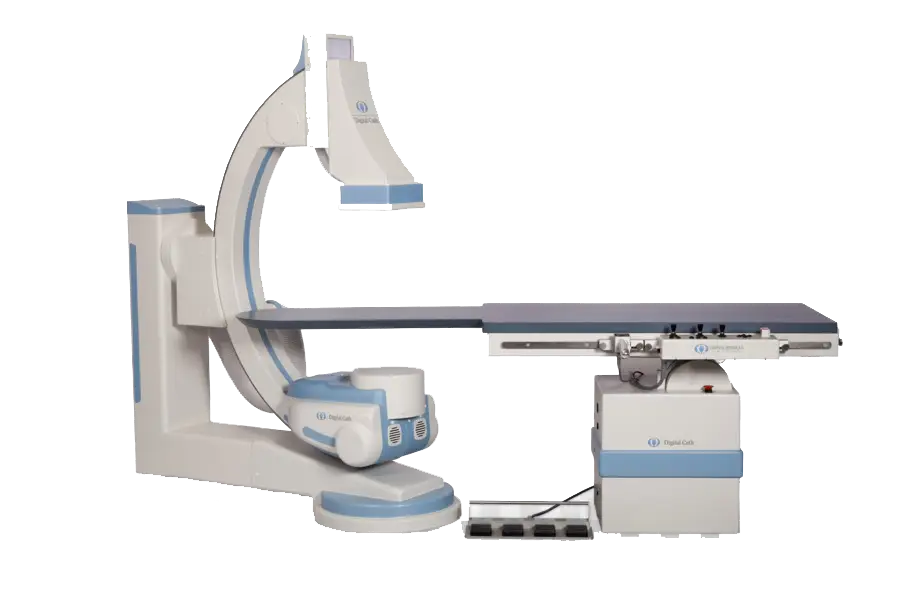Cath Lab
Cath labs are specialized medical centers that use advanced technologies to diagnose and treat patients with heart-related conditions. They provide various services to ensure everyone receives the care they need, including angiography, coronary interventions, electrophysiology, and interventional cardiology procedures.
Using state-of-the-art imaging technology and equipment, cath labs help doctors identify blockages in vessels or other issues within the body's cardiovascular system. From there, they can perform various tests and treatments to diagnose and address underlying conditions. This can include using balloons, stents, or other devices to open up blocked arteries or inserting pacemakers into the heart muscle for those with an abnormal heartbeat.
Cath labs aim to provide comprehensive, individualized care for patients with heart-related conditions so they can live healthier lives.

Conditions Treated
Cath labs are an essential tool in diagnosing and treating various heart-related conditions, including heart attacks, coronary artery disease, and arrhythmias. They provide doctors with a comprehensive view of the cardiovascular system, allowing them to identify any underlying cardiac issues quickly and accurately.
For those suffering from a heart attack, cath labs can locate blocked arteries or vessels and address them through angioplasty or other procedures. Cardiac catheterization also enables doctors to diagnose and treat coronary artery disease by inserting stents or balloons into vessels narrowed by plaque buildup to widen them. Additionally, it can be used to correct rhythm irregularities such as arrhythmias, which can cause serious complications if left untreated.
By providing a detailed picture of the cardiovascular system, cath labs enable doctors to create individualized treatments for each patient's specific needs. This helps ensure everyone receives the care they require to lead healthier lives.
Treatment Procedures
Cath labs offer a variety of catheter-based treatments to diagnose and address heart-related conditions.
Angioplasty is one of the most common procedures performed in the cath lab. During this procedure, a thin catheter tube is inserted into an artery near the area with blockage or narrowing. Once the catheter has reached its destination, a balloon at the end of the tube will be inflated to open up any blockages and restore blood flow. This type of treatment can greatly reduce symptoms associated with heart disease or even prevent further damage from occurring.
Stenting is another procedure used in cath labs to help open blocked arteries and prevent them from narrowing again. This involves inserting a small metal mesh tube, a stent, into the affected artery to expand it and reduce pressure. Stents are also occasionally used with angioplasty to ensure that arteries stay open for years.
In addition to these two major procedures, cath labs can perform other interventions, such as electrical stimulation for arrhythmia and embolization for stroke victims. While all of these treatments have shown promise in alleviating various heart conditions, they are not without risks, including bleeding, infection, stroke, and death. That being said, when administered by highly skilled medical professionals, they can be incredibly effective tools for those dealing with medical issues related to heart disease or other cardiovascular diseases.
Recovery and Aftercare
After treatment in the cath lab, patients may experience some discomfort and experience a slight drop in their activity levels while they heal. It is important to follow all instructions provided by your doctor during this period, including taking prescribed medications or avoiding strenuous activities.
For most people, recovery time is relatively short, and symptoms such as pain or tightness in the chest usually disappear within days or weeks. Patients should also attend any follow-up appointments set up by their doctor to ensure that the procedure is successful.
To maintain their cardiac health following cath lab treatment, it is recommended that patients make lifestyle changes, including eating a healthy diet, exercising regularly, and quitting smoking if applicable. Regular check-ups with a cardiovascular specialist are also necessary to monitor the heart's condition, especially for those at risk for further complications such as coronary artery disease.
Experts in the cath lab
The cath lab is staffed by a team of highly skilled medical professionals with extensive experience in diagnosing and treating heart conditions. This team typically includes cardiologists, interventional radiologists, cardiac surgeons, and other healthcare personnel who specialize in caring for patients with cardiovascular issues. All team members are rigorously trained in the latest technology and treatments available to provide the best care possible for their patients.
In addition to requiring years of specialized training and experience, members of the cath lab staff must also have a thorough understanding of how the human heart functions and how different types of treatments can help alleviate its symptoms. This expertise allows them to deliver precise and effective treatments that offer long-term solutions to those dealing with heart-related issues or complications.
Advanced Equipments & Technology
The cath lab has the most advanced technology to diagnose and treat cardiac conditions. This includes tools such as CT scanners, X-ray machines, echocardiography systems, angiography systems, and other imaging equipment that allow physicians to analyze the heart's structure and function.
The use of this cutting-edge technology allows physicians to gain a better understanding of their patient's condition and develop targeted treatments that offer long-term solutions. This includes performing minimally invasive procedures such as stenting or angioplasty to clear blocked arteries, inserting pacemakers or defibrillators to regulate irregular rhythms, or using coronary bypass surgery to replace damaged or diseased coronary arteries. These procedures are all made possible through state-of-the-art equipment in the cath lab.
Addressing common concerns
Many patients may feel anxious or overwhelmed when facing a trip to the cath lab. It's important to provide them with accurate information about what to expect before, during, and after the procedure. Patients should ask their doctor questions, such as what the procedure entails, how long it will take, any risks they should be aware of, and what the recovery process is like.
For instance, many patients report minimal discomfort during the procedure and being surprised by how quickly everything was completed. Afterward, most find that they do not experience pain and can often return home within one or two hours, depending on the complexity of their procedure.
Patients need to prepare for their visit with some basic guidelines. These include following the doctor's instructions regarding eating or drinking before the appointment, abstaining from strenuous activity on the day of their visit, and arranging for transportation home afterward if necessary. By following these tips, patients can ensure a smoother experience at the cath lab.


